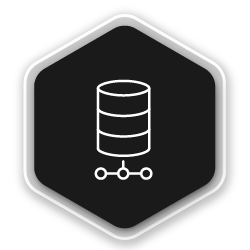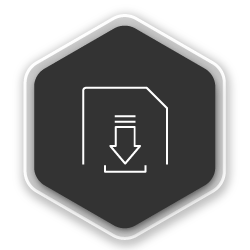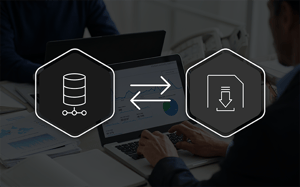Regardless of your retail format, or the products you sell in-store, it's vital you have a system that allows you to track your inventory. But what happens if you stock items that do not arrive with barcodes? Or, the items don't lend themselves to having barcodes on them? In both instances, PLU codes can help you.
That’s one reason (of many) why you should consider using them in your store. We’ll dig into the other benefits of applying PLU codes later on in this article. For now, it’s first worth unpacking the term and placing it into context.

What are PLU codes?
PLU codes or price look-up codes go by various names, depending on who you speak to. You can refer to them as PLU numbers, PLUs, produce codes, or produce labels.
Regardless of the name you use to describe them, it is essentially an identification number to help you track and monitor the movement of individual products into and out of your store. Usually 4 or 5-digit numbers, these codes are both administered and controlled worldwide by the International Federation for Produce Standards (IFPS).
According to the organization, there are currently around 1400 global PLU codes assigned to fresh produce items. And, while you can apply for new codes if one doesn’t exist for a product, you do need to meet strict criteria, which cover, amongst others, commodity; variety; item size; distribution, and product or sales volumes.
Let’s consider the variety criteria as an example. If you want the IFPS to grant a new PLU number for Apples, the item must be a unique variety. It helps if can show that you’ve developed a new variation because since there are already countless price look-up codes for the different apple varieties, you must provide reasons why it deserves a new code.
Create powerful category reviews with DotActiv’s advanced retail analytics software
That said, it’s worth noting that the PLU system is voluntary. You don’t need to label your products with produce codes if you don’t believe your business needs them. However, it can help you to keep track of what’s going on across your stores.
Let’s say, for example, you sell fruit and produce individually instead of in a box. It could either be specific items or your entire produce section. Either way, how would you know how many you sell each month if you don’t include a code or label to track their movement? The short answer is you’ll struggle.

Why should your store consider PLU codes?
If you stock and sell produce items individually, implementing PLU codes isn’t so much a suggestion as it’s a recommendation. As already noted above, it's one of many best practices for ensuring proper inventory control.
However, that’s not the only benefit of using them in-store.
1. They help you to have better control of your inventory
The fact that you have a PLU system that tracks the products you buy from your suppliers and sell to customers means you’ll naturally have more control of your inventory.
Since you should have a record of your stock levels, you’ll know how much product you have on your shelf and in your storeroom. That allows you to determine when to place new orders, which allows you to put measures in place to avoid any future out-of-stock and overstocking issues.
Now let’s consider the above scenario without a PLU system.
Imagine you’re ordering a pallet of oranges. That pallet should be 200 oranges. Without a system, you’d need to record that number manually. Your supplier might also not use a PLU code and they insist that there are 200 when in reality, there are 180. You’re in a rush, you trust them, and they charge you for 200.
After selling your stock, you might chalk up the difference to theft. How are you to know any different? You’ll struggle to determine where the theft happened.
By keeping track of your stock at all times, you can quickly notice if anything goes missing. As you have the paperwork showing you received the stock, and the POS data to show which products you stock, you’ll have a starting point. From there, you can begin questioning the right people and making any necessary changes to your processes.
2. They help you to understand the sales of each product per supplier
Data is the here and now and future of decision-making. If you don’t use data to inform your decisions, you are wasting your time and money. That might sound harsh, but it’s true.
It’s especially pertinent to any buying decisions that you make as a retail business. You buy products from suppliers based on consumer needs and facts. If your retail data doesn’t support the need to stock a large quantity of Product A, then you should adhere to that information.
It’s the same for analyzing any products that you currently stock.
Let’s say that you’ve stocked Product A for a few months and the data shows that it sells well. However, recently, you notice a blip. Sales for the month are down. Then it happens a second month so you need to consider your options. It could mean stocking less of the product and giving shelf space to a product that sells.
Because you can link supplier information to a price look-up number, you can decide on whether to continue stocking a product, reducing the range, or deranging it.
Another concept is to consider the local versus international argument. Is it worth stocking an international product when there is a local producer who can give you a better price and the same level of quality and service?
By stocking both products on a trial basis, and tracking their sales, you can make a final decision.
3. They help you to correctly identify products
PLU codes remove the manual guesswork associated with identifying products and assigning the correct prices to items at check-out.
What’s more, it makes everything that much easier as you can standardize or preprogram all the information into a system. There is also the point that it can help you to avoid any unnecessary human errors.
Let’s say, for example, you have a conversation with a new supplier about the produce they wish to sell you but you don’t use a PLU system. Let’s use the example of apples again. You agree to a price of $1.50 per pound and begin selling them. However, you might have new staff who don’t know the set price. Senior staff are absent and it's a busy day. Instead of selling at $1.50 per pound, thinking the price is lower, your staff sell it at 75 cents.
Besides the obvious fact that you’re not making as much money as you’d expect on an item, there is another issue that could arise. It’s the issue of selling a product that may look the same as the one sold at $1.50 per pound. However, it’s a different variety with a different price.
That can directly influence your stock controls, which can also lead to shelf space problems. By not implementing a system, you could find yourself over-ordering on one product, and under-ordering on another. Also, you might have to mark down some products to get rid of them.
4. They help you to reduce transaction time at check-out
Alongside the point that PLU codes remove the manual guesswork is another: it minimizes labor at the point of sale, thereby reducing any unnecessary transaction time.
How?
The manual process of inputting a PLU code is time-consuming for your staff. Once a customer brings an item to the check-out counter, they would need to remember the code. That’s if there is no label. Then scan it or type it in manually. If they don’t have the price look-up number or can’t remember it, that means holding up the queue as they search for it, either all by themselves or after calling a supervisor for help.
Consider you are that customer waiting for the cashier to find the code to scan it. Moreover, there are ten people in the queue behind you each with different fruit and vegetables, some with labels, others without. You’ll undoubtedly feel frustrated and maybe even embarrassed as you’re holding up the queue.
The converse is true. By including clear produce labels and investing in a system, you can allow for quicker queuing times and happier customers, who will return. Also, the faster and more convenient you make the check-out process, the more you can get done.
Imagine using a system that frees up five minutes every hour for each of your staff. If you have 10 cashiers, that’s 50 minutes for every hour saved and six and a half hours per day.
Conclusion
With integrated category management software such as DotActiv Enterprise or Pro, you have every possibility of not only tracking your inventory throughout your business but also selecting those products that offer you the best return on your investment. Visit our online store here.


